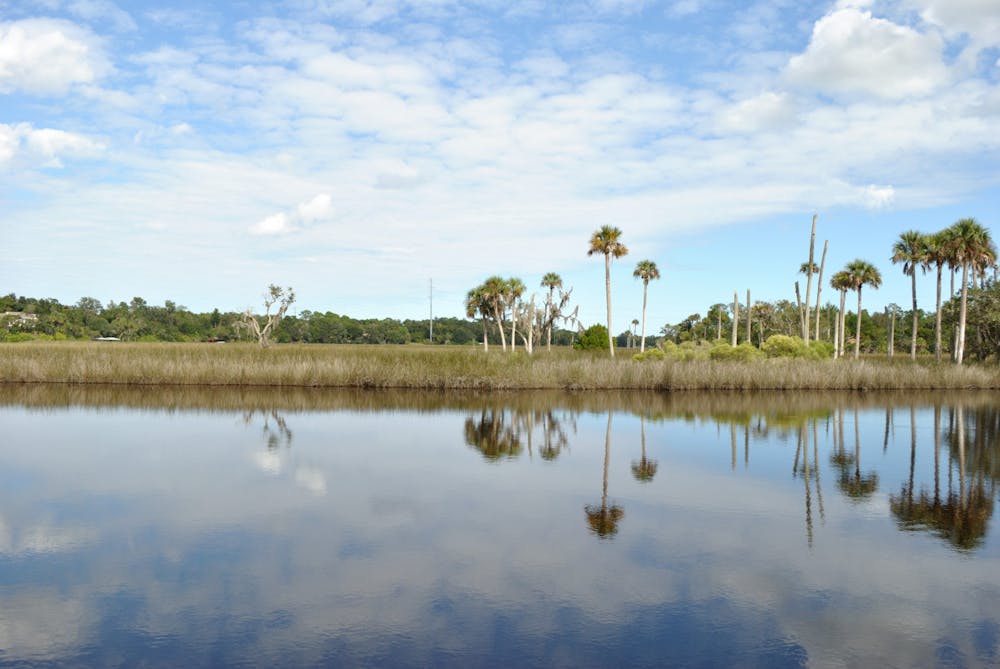Derek LaMontagne spent his midterm season in a courtroom.
The 38-year-old UF graduate chemistry student, along with other petitioners, brought a case against the construction of the Pioneer Trail Highway Interchange off I-95 in Volusia County.
LaMontagne filed the case with Bryon White, Bear Warriors United and The Sweetwater Coalition of Volusia County April 18. The case was filed against the Florida Department of Transportation and the St. Johns River Water Management District, with the primary concern the interchange will cause excess environmental harm.
“The ecosystem is at a point of failure,” LaMontagne said. “It will basically be a catastrophe for all of the Spruce Creek watershed.”
LaMontagne is a member of Save Don’t Pave Spruce Creek, an organization with the goal of protecting the Spruce Creek watershed. The Pioneer Trail Interchange will demolish over 60 acres of wetlands within the Spruce Creek area, which LaMontagne said would be disastrous for the watershed.
Vital habitat for species like black bears, manatees and gopher tortoises would be destroyed. Spruce Creek would no longer serve as a wildlife corridor, further separating habitats in Volusia County. Spruce Creek is designated as an outstanding Florida waterbody, making it vital to Florida’s environment.
Outstanding Florida water bodies are protected under state law, LaMontagne said, making the approved interchange and subsequent wetland destruction illegal. However, LaMontagne had to fight much of the legal battle against FDOT without an attorney.
LaMontagne began representing himself and the other petitioners on Aug. 1, after their joint legal counsel withdrew due to “irreconcilable differences.” The hearing concluded Oct. 27, with a decision from the judge expected to come in January.
LaMontagne has no legal training, whereas the opposition had an expensive team of lawyers, he said. However, LaMontagne felt the petition was important enough to pursue, even if he had to defend it himself. After growing up in the Spruce Creek area, LaMontagne said he’s been a firsthand witness to the impacts of overdevelopment.
“This is especially egregious because they are [developing] without this underlying layer of protection,” he added.
Lewis, Longman & Walker, the firm representing FDOT and the St. Johns River Water Management District, declined to comment on the case.
This isn’t the first time LaMontagne has battled with the firm. The Pioneer Trail interchange is the fourth time LaMontagne has filed environmental petitions in court. Each time, Lewis, Longman & Walker defended the respondents.
LaMontagne filed a petition in 2017 alongside the Friends of Spruce Creek Preserve against the St. Johns River Water Management District and Woodhaven LLC. The petition alleged that Woodhaven, a housing development of ICI Homes near the Pioneer Trail interchange, didn’t meet proper environmental permitting requirements.
The CEO of ICI Homes, Mori Hosseini, also holds the role of chairman for the UF board of trustees. Bryon White, another petitioner in the Pioneer Trail case, alleged the interchange is being built as a political favor from Gov. Ron DeSantis to Hosseini, his longtime supporter.
Hosseini donated $1 million to DeSantis’ presidential campaign, and has also provided gifts such as a golf simulator and private flights. Hosseini, who was unable to be reached for comment, has spoken publicly in favor of the Pioneer Trail interchange.
“There’s no such thing as coincidence in this sort of deal,” White said.
The interchange is estimated to cost a total of $120 million, with the majority coming from leftover COVID-19 relief funds. DeSantis directed $92 million from the American Rescue Plan Act to be used for the interchange, a decision that White said doesn’t reflect the interests of local residents.
“What is happening to Spruce Creek is not unusual or rare in the state,” White said. “But this one hurts and it hits close to home.”
In 2022, Volusia County Council Chairman Jeff Brower sent a letter to DeSantis and members of FDOT in opposition to the interchange. Brower argued in his letter that the interchange misused taxpayer funds caused environmental harm and was opposed by the majority of Volusia citizens.
Brower never officially heard back from the governor or other recipients of his letter, he said.
Most of the residents he’s spoken to are adamantly opposed to the interchange, Brower said. Volusia County is already experiencing severe flooding and water pollution issues, he added, which will only be worsened by an increase in development.
Residents on both sides of the political spectrum are concerned about the future of Spruce Creek.
“There’s money available to buy land there and protect it,” Brower added. “But instead we’re spending to do an interstate exchange where it’s not needed.”
Citizens submitted public comments to the River To Sea Transportation Planning Organization at the beginning of 2023 regarding the interchange. Nearly all comments were opposed to the interchange and cited everything from health concerns to traffic congestion and environmental degradation.
“Please do not ruin this beautiful area with traffic,” one resident said.
“This is critical wild land that should be protected at all costs. Once it is bulldozed, filled in, devoured by developers, it is gone forever. And then where do the animals go?” another commented.
Lori Sandman, a resident of Volusia County, said she’s concerned with how the interchange will impact the Spruce Creek area during major hurricanes. Without wetlands there to absorb stormwater runoff or storm surge, residential areas could see major flooding effects.
Sandman also worries property values near the interchange will fall and insurance costs will rise as flooding becomes more serious. This may cause some longtime Volusia County residents to move out of the area, she added.
“We don’t oppose development,” Sandman added. “We oppose developing wetlands without consideration of where the water can be directed.”
Contact Kylie Williams at kyliewilliams@alligator.org. Follow her on Twitter @KylieWilliams99.
Kylie Williams is the Fall 2024 Enterprise Editor and a junior journalism major. Previously, she worked for the enterprise desk as the environment reporter. In her free time, she can be found reading, baking or watching reality TV with her cat.






